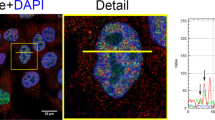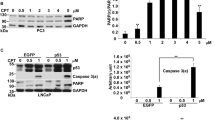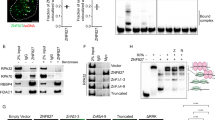Abstract
Previous studies have shown that human topoisomerase I interacts directly with the tumor-suppressor protein p53. In the past few years it has repeatedly been suggested that topoisomerase I and p53 may play a joint role in the response to genotoxic stress. This led to the suggestion that p53 and human topoisomerase I may cooperate in the process of DNA repair and/or apoptosis. Recently we have demonstrated that a human topoisomerase I cleavage complex can be recognized by an additional topoisomerase I molecule and thereby form a so-called double cleavage complex. The double cleavage complex creates an about 13 nucleotides long single-stranded gap that may provide an entry site for recombinational repair events. Here we demonstrate that p53 stimulates both the DNA relaxation activity as well as the formation of the human topoisomerase I double cleavage complex by at least a factor of six. Stimulation of topoisomerase I activity by p53 is mediated via the central part of topoisomerase I. We also show that human, bovine, and murine p53 stimulate human topoisomerase I relaxation activity equally well. From these results it is conceivable that p53's stimulatory activity on topoisomerase I may play a role in DNA recombination and repair as well as in apoptosis.
This is a preview of subscription content, access via your institution
Access options
Subscribe to this journal
Receive 50 print issues and online access
$259.00 per year
only $5.18 per issue
Buy this article
- Purchase on Springer Link
- Instant access to full article PDF
Prices may be subject to local taxes which are calculated during checkout





Similar content being viewed by others
References
Albor A, Kulesz-Martin M . 2000 DNA Alterations in Cancer Ehrlich M (ed) Natrick MA: Eaton Publishing pp. 409–422
Albor A, Kaku S, Kulesz-Martin M . 1998 Cancer Res. 58: 2091–2094
Andersen AH, Bendixen C, Westergaard O . 1996 DNA Replication in Eukaryotic Cells DePamphilis ML (ed) Cold Spring Harbor, NY: Cold Spring Harbor Laboratory Press pp. 587–617
Bischoff JR, Friedman PN, Marshak DR, Prives C, Beach D . 1990 Proc. Natl. Acad. Sci. USA 87: 4766–4770
Bradford MM . 1976 Anal. Biochem. 72: 248–254
Cao Y, Gao Q, Wazer DE, Band V . 1997 Cancer Res. 57: 5584–5589
Christiansen K, Westergaard O . 1999 Biochim. Biophys. Acta. 1489: 249–262
Degtyareva N, Subramanian D, Griffith JD . 2001 J. Biol. Chem. 276: 8778–8784
Dequiedt F, Willems L, Burny A, Kettmann R . 1995 DNA Seq. 5: 261–264
Friedman PN, Chen X, Bargonetti J, Prives C . 1993 Proc. Natl. Acad. Sci. USA 90: 3319–3323
Frosina G, Rossi O . 1992 Carcinogenesis 13: 1371–1377
Gobert C, Bracco L, Rossi F, Olivier M, Tazi J, Lavelle F, Larsen AK, Riou JF . 1996 Biochemistry 35: 5778–5786
Gobert C, Skladanowski A, Larsen AK . 1999 Proc. Natl. Acad. Sci. USA 96: 10355–10360
Haluska Jr P, Saleem A, Edwards TK, Rubin EH . 1998 Nucleic. Acids Res. 26: 1841–1847
Haluska Jr P, Saleem A, Rasheed Z, Ahmed F, Su EW, Liu LF, Rubin EH . 1999 Nucleic. Acids Res. 27: 2538–2544
Jayaraman L, Prives C . 1999 Cell. Mol. Life Sci. 55: 76–87
Jones JC, Stevnsner T, Mattern MR, Bohr VA . 1991 Mutat. Res. 255: 155–162
Labourier E, Rossi F, Gallouzi IE, Allemand E, Divita G, Tazi J . 1998 Nucleic. Acids Res. 26: 2955–2962
Lane DP . 1992 Nature 358: 15–16
Lanza A, Tornaletti S, Rodolfo C, Scanavini MC, Pedrini AM . 1996 J. Biol. Chem. 271: 6978–6986
Lee S, Elenbaas B, Levine A, Griffith J . 1995 Cell 81: 1013–1020
Mao Y, Mehl IR, Muller MT . 2002 Proc. Natl. Acad. Sci. USA 99: 1235–1240
Mao Y, Okada S, Chang LS, Muller MT . 2000 Cancer Res. 60: 4538–4543
May P, May E . 1999 Oncogene 18: 7621–7636
Megonigal MD, Fertala J, Bjornsti M-A . 1997 J. Biol. Chem. 272: 12801–12808
Pouliot JJ, Robertson CA, Nash HA . 2001 Genes Cells. 6: 677–687
Pouliot JJ, Yao KC, Robertson CA, Nash HA . 1999 Science 286: 552–555
Pourquier P, Ueng L-M, Fertala J, Wang D, Park H-J, Essigman JM, Bjornsti M-A, Pommier Y . 1999 J. Biol. Chem. 274: 8516–8523
Pourquier P, Ueng L-M, Kohlhagen G, Mazumder A, Gupta M, Kohn KW, Pommier Y . 1997a J. Biol. Chem. 272: 7792–7796
Pourquier P, Pilon AA, Kohlhagen G, Mazumder A, Sharma A, Pommier Y . 1997b J. Biol. Chem. 272: 26441–26447
Pourquier P, Takebayashi Y, Urasaki Y, Gioffre C, Kohlhagen G, Pommier Y . 2000 Proc. Natl. Acad. Sci. USA 97: 1885–1890
Pourquier P, Waltman JL, Urasaki Y, Loktionova NA, Pegg AE, Nitiss JL, Pommier Y . 2001 Cancer Res. 61: 53–58
Ryan AJ, Squires S, Strutt HL, Johnson RT . 1991 Nucleic. Acids Res. 19: 3295–3300
Sigal A, Rotter V . 2000 Cancer Res. 60: 6788–6793
Snapka RM, Powelson MA, Strayer JM . 1988 Mol. Cell. Biol. 8: 515–521
Søe K, Dianov G, Nasheuer H-P, Bohr VA, Grosse F, Stevnsner T . 2001 Nucleic. Acids Res. 29: 3195–3203
Squires S, Ryan AJ, Strutt HL, Smith PJ, Johnson RT . 1991 J. Cell. Sci. 100: 883–893
Stevnsner T, Bohr VA . 1993 Carcinogenesis 14: 1841–1850
Stewart AF, Herrera RE, Nordheim A . 1990 Cell 60: 141–149
Stewart AF, Schutz G . 1987 Cell 50: 1109–1117
Stewart L, Ireton GC, Champoux JJ . 1996 J. Biol. Chem. 271: 7602–7608
Stürzbecher HW, Brain R, Addison C, Rudge K, Remm M, Grimaldi M, Keenan E, Jenkins JR . 1992 Oncogene 7: 1513–1523
Subramanian D, Rosenstein BS, Muller MT . 1998 Cancer Res. 58: 976–984
Thielmann HW, Popanda O, Gersbach H, Gilberg F . 1993 Carcinogenesis 14: 2341–2351
Tsao Y-P, Russo A, Nyamuswa G, Silber R, Liu LF . 1993 Cancer Res. 53: 5908–5914
Vogelstein B, Kinzler KW . 1992 Cell 70: 523–526
Wang Y, Reed M, Wang P, Stenger JE, Mayr G, Anderson ME, Schwedes JF, Tegtmeyer P . 1993 Genes Dev. 7: 2575–2586
Weisshart K, Förster H, Kremmer E, Schlott B, Grosse F, Nasheuer HP . 2000 J. Biol. Chem. 275: 17328–17337
Wood RD, Biggerstaff M, Shivji MKK . 1995 Methods: A Companion to Methods Enzymol. 7: 163–175
Wu J, Liu LF . 1997 Nucleic. Acids Res. 25: 4181–4186
Yang SW, Burgin Jr AB, Huizenga BN, Robertson CA, Yao KC, Nash HA . 1996 Proc. Natl. Acad. Sci. USA 93: 11534–11539
Yang L, Wold MS, Li JJ, Kelly TJ, Liu LF . 1987 Proc. Natl. Acad. Sci. 84: 950–954
Acknowledgements
We wish to thank the undergraduate students Michael Stilmann and Falk Remane for purification of htopoI used in the Far-Western analysis. This work was sponsored by the Deutsche Krebshilfe.
Author information
Authors and Affiliations
Corresponding author
Rights and permissions
About this article
Cite this article
Søe, K., Hartmann, H., Schlott, B. et al. The tumor suppressor protein p53 stimulates the formation of the human topoisomerase I double cleavage complex in vitro. Oncogene 21, 6614–6623 (2002). https://doi.org/10.1038/sj.onc.1205912
Received:
Revised:
Accepted:
Published:
Issue Date:
DOI: https://doi.org/10.1038/sj.onc.1205912
Keywords
This article is cited by
-
The prolyl cis/trans isomerase cyclophilin 18 interacts with the tumor suppressor p53 and modifies its functions in cell cycle regulation and apoptosis
Oncogene (2009)
-
p53 in recombination and repair
Cell Death & Differentiation (2006)



